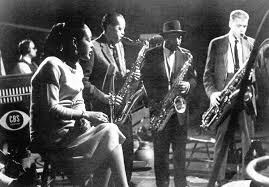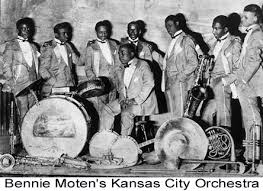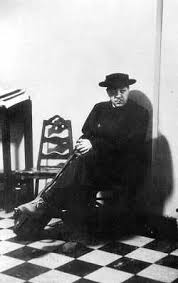Hail to the Pres: Celebrating Lester Young's Birthday
by Con Chapman
Today is the 102nd anniversary of the birth of Lester Young in Woodville, Mississippi. When he died six months short of a half century in 1959, he was recognized among his peers as an innovator without equal, the man whose solos formed a bridge between the swing era and bebop. At a time when jazz had its share of royalty—kings, dukes, and counts—Young was democratically elected “the President” (shortened to “Pres”) by an aristocratic vote of one; the best jazz singer then alive, his sometime lover Billie Holiday.

Lester Young: Always angular, never coming straight at you.
He was known as well to popular music fans, if not by name then by aural osmosis as the lilting tenor in the Count Basie recordings to which they danced in the 30′s, and then as a fading eminence who appeared in the short film Jammin' the Blues and the television special The Sound of Jazz in the late 50′s. That he is unknown today except to jazz fans whose devotion to the art qualifies them as hard-core is a sad commentary on our capacity to recognize genius among us when it appears.

Billie Holiday and Lester Young
Young grew up in a musical family that played the full repertoire of American song from its base in Minneapolis, before audiences at events ranging from minstrel shows to private parties. He must have developed the sly sense of melodic irony that characterized his style at its peak by playing “Back Home Again in Indiana” for the 100th, then the 500th time in his life during these years.
Lester Young, with the Count Basie band
When he left his family band for good in 1930 he struck out for Kansas City, where he played with four of the groups that built the foundation of the free-swinging, riff-based jazz that we associate with that city; Bennie Moten and His Kansas City Orchestra, Walter Page's Blue Devils, Andy Kirk and His Twelve Clouds of Joy, and Count Basie.

Bennie Moten's Kansas City Orchestra
He transformed the loose gait that he developed in those bands into a style that was a precursor of what we now refer to as cool. When he left Basie to join Fletcher Henderson, he was expected to play in the overpowering manner of Coleman Hawkins, the tenor he replaced. Instead, he was laid back, both physically and literally, as he slouched in his chair, his horn tilted at an oblique angle that proclaimed his indifference to everything but his art. Well, almost everything. Musicians who sat next to him reported that he would alert them to the presence of attractive females around the bandstand with messages in his private, off-beat argot: “Startled fawn at 11 o'clock,” he once remarked to a colleague, referring to a particularly wide-eyed admirer down front.

Fletcher Henderson
Young's spirit was broken by a stint in the Army during World War II, where he encountered racism and regimentation to which his artistic nature were ill-suited. He emerged, in many critics' estimation, a broken man whose playing never equalled his youthful output, but others hear in his recordings in the 1950s a deeper sensibility, his emotions now showing through the worn fabric of his being.

Young in his later years, wearing trademark porkpie hat.
Young's life ended sadly as he drank himself to death, embittered by the success of his white imitators and the loss of the best years of his life. He ranks today among the three greatest tenors of all time, but few see past the high, mighty and wind-blown peak of John Coltrane, the most recent mountain in that extended range, to see his more subtle, nuanced and filigreed art.
|
1
fav |
1528 views
3 comments |
639 words
All rights reserved. |
Author's Note
The author has not attached a note to this story.
Other stories by Con Chapman
Tags
This story has no tags.
Great writing, as always, and great pictures, too. Lester is one of my all time favorites.
Educational and enlightening. Well done [again].
Thanks. I actually heard his version of "Love Me or Leave Me" playing in Starbucks the other day--maybe he's in for a revival.